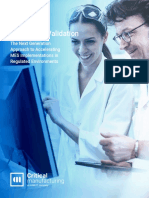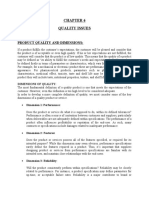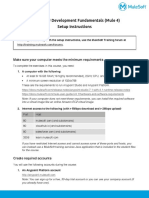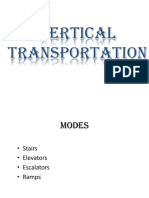Calibration and ISO 9000
Calibration and ISO 9000
Uploaded by
iresendizCopyright:
Available Formats
Calibration and ISO 9000
Calibration and ISO 9000
Uploaded by
iresendizCopyright
Available Formats
Share this document
Did you find this document useful?
Is this content inappropriate?
Copyright:
Available Formats
Calibration and ISO 9000
Calibration and ISO 9000
Uploaded by
iresendizCopyright:
Available Formats
Calibration and ISO 9001:2000 A manufacturers calibration program is the basis of its quality controlling activities.
A good calibration program can do more than reduce scrap rates. It can reduce expenditures for measurement instruments and related services, add to the confidence and expertise of the companys staff, and increase the customers perception of company performance. A good calibration program can protect the company from big risk, and provide records of internationally standardized metrology that would be hard to dispute. It can be said that a manufacturers calibration program is built upon three foundations. First, an understanding of the technical details of the tools in use must be maintained and utilized. Second, the measurement unit in use must be traceable to the internationally agreed upon standard. Third, the calibration program must be managed. Valid calibration procedures Measurement instruments and tools differ greatly in construction and intent, and the specific activities necessary to calibrate these tools are just as varied. An understanding of the operation of each tool allows problems to be detected, adjustments to be made properly, and condition of tools to be assessed. These technical details are found in calibration procedures. The calibration procedure, to be effective, has to be valid to the tool that will be calibrated. It is very important for a manufacturer to design its calibrations around the specific tools and how they will be used. There are many sources of historically validated calibration procedures for dimensional metrology tools. Many valid calibration procedures are available through activities of the United States Government. Standards that are published by different branches of the military may be available to civilian contractors, if they do business with government. Freely distributed standards published by the government and military are readily available online. Trade organizations publish standards that can be purchased. The manufacturers of dimensional metrology tools can also be a great source of valid, proven calibration procedures. Calibration laboratories used for calibration of more complicated or demanding tools and reference specimens may be willing to share their procedures. Staff experience can also be an excellent source of data on calibration. Traceability The definition of traceability that has achieved global acceptance in the metrology community is contained in the International Vocabulary of Basic and General Terms in Metrology (VIM; 1993): "the property of the result of a measurement or the value of a standard whereby it can be related to stated references, usually national or international standards, through an unbroken chain of comparisons, all having stated uncertainties." Traceability of a measurement unit is really maintained by a dual chain of metrology that goes back to the international standard. Each comparison is accompanied by an estimation of measurement uncertainty. Measurement uncertainty is calculated through an internationally standardized discipline. While some might consider measurement uncertainty calculations complex or time consuming, the actual process is really not that difficult. Experience shows that with just a little bit of practice most people who have a basic knowledge of metrology can successfully identify the three to five largest uncertainty contributors. That is all it takes to make an uncertainty budget that is within 20% of the correct value, which is close enough to make it a valuable tool. (Palumbo, 2006) Measurement uncertainty calculations are not explicitly required by ISO 9001:2000. This revisions less proscriptive and more widely applicable foundation leaves it up to the manufacturer to decide what the requirements of the individual measurement processes are. The requirements are then based on real world considerations of law, regulations, safety, customer requirements, applicable standards, and performance of the manufacturers measurement process itself.
The requirements for calibration of measurement tools can be found in section 7.6 of ISO 9001:2000. For insight into this section, it is useful to refer to the manufacturing centered 1994 version of ISO 9000. Section 4.11, Control of Inspection, Measuring, and Test Equipment states that measuring equipment is used in a manner that ensures that the measurement uncertainty is known and is consistent with the required measurement capability. The intent of the requirements in both versions is the same. In-house calibrations that are not accompanied by measurement uncertainty estimates have broken the chain of traceability. Management An ISO 9001:2000 management system strives to attain customer satisfaction through continual improvement of processes. In manufacturing, calibration and measurement is one of the most important processes we can define. The management of the calibration process is accomplished in the same way as management of the other processes identified in the manufacturers management system. A cycle of planning, action, measurement and management will complete the solid basis of instrument calibrations, both those performed in-house and those outsourced to calibration laboratories. Some manufacturers may choose to develop a calibration system manual which contains the process description, planned quality objectives, key indicators of process performance and references to the standards and procedures in use. This can become a very valuable document that serves as the roadmap to a dynamic, effective, top notch calibration program. Good metrology delivers information about the manufacturers products. Using this information in an ISO 9000 based management system creates knowledge about the manufacturers products, machines and processes, capabilities, and tools. A good calibration program will provide some immediate economic benefits and deliver protection from problems, but calibration is not a core business for most manufacturers. Internal calibration is not a product, and the immediate economic benefits of good metrology will be very limited or not even seen. However, a good calibration program will develop confidence on the factory floor that the company is dedicated to providing quality product. It will develop capability and expertise. It will develop pride in company staff, knowing fully well that their system is one of the best, and is only getting better. Good calibration is good metrology, which is a core aptitude of manufacturing organizations. It can only bolster and empower the organization as a whole.
1. International Vocabulary of Basic and General Terms in Metrology (VIM), BIPM, IEC, IFCC, ISO, IUPAC, IUPAP, OIML (1993). 2. Palumbo, Robert. Gage Calibration Is an Investment in Quality Production. Quality Digest Feb. Mar. 1997
You might also like
- AS9100c WorkbookDocument108 pagesAS9100c Workbookfunkler100% (2)
- ISO 9001:2015 Explained, Fourth Edition: Download PDF HereDocument3 pagesISO 9001:2015 Explained, Fourth Edition: Download PDF HereiresendizNo ratings yet
- Assignment DCC40132Document6 pagesAssignment DCC40132Ammar ZikryNo ratings yet
- Importance of CalibrationDocument8 pagesImportance of CalibrationBojana CvetkovicNo ratings yet
- X02QSDocument7 pagesX02QStrungthanhnguyen_83No ratings yet
- Role of QC & QA in OperationsDocument6 pagesRole of QC & QA in OperationsmaheshNo ratings yet
- FDIC Quality Assurance StandardsDocument21 pagesFDIC Quality Assurance StandardsGennae LynchNo ratings yet
- Welcome To Calibration Basics!Document30 pagesWelcome To Calibration Basics!Ver Bautista100% (1)
- Aerospace Quality Management SystemsDocument10 pagesAerospace Quality Management SystemsvarishaNo ratings yet
- ISO 17025 Measurement TraceabilityDocument9 pagesISO 17025 Measurement TraceabilityParv BhardwajNo ratings yet
- Software Project Management Assignment IIDocument5 pagesSoftware Project Management Assignment IIvinayak vishwajitNo ratings yet
- Quality ManagementDocument78 pagesQuality ManagementKiran MittalNo ratings yet
- Calibration and ValidationDocument14 pagesCalibration and ValidationMd. Ashikur RahamanNo ratings yet
- ISO 9001 Training and GuidelinesDocument102 pagesISO 9001 Training and GuidelinesJaved Iqbal100% (1)
- 81W 27244 0 CalbrationDocument4 pages81W 27244 0 CalbrationSrikant SuruNo ratings yet
- X17AUDITDocument10 pagesX17AUDITtrungthanhnguyen_83No ratings yet
- 07 Production and Operations Management (Quality Control)Document34 pages07 Production and Operations Management (Quality Control)Naufal ArndoNo ratings yet
- Quality Control ConceptsDocument31 pagesQuality Control ConceptsrajeshwariNo ratings yet
- What Is Calibration?Document2 pagesWhat Is Calibration?Franny Mary Beato PereyraNo ratings yet
- Quality Control: Chapter OutlineDocument40 pagesQuality Control: Chapter OutlineLoreine Jane ClaritoNo ratings yet
- Whitepaper AutomatedvalidationDocument18 pagesWhitepaper AutomatedvalidationOscar Macias0% (1)
- ISO9001 2008comparisonDocument2 pagesISO9001 2008comparisonsubhash_savitaNo ratings yet
- Quality Control SummaryDocument22 pagesQuality Control SummaryamramadanNo ratings yet
- 97 09Document14 pages97 09Naman VermaNo ratings yet
- Calibration CertificateDocument3 pagesCalibration CertificateMARIBETH AGUBANo ratings yet
- Establish Quality Standard ASS2 New 1 AaaDocument4 pagesEstablish Quality Standard ASS2 New 1 AaaAlem GirmaNo ratings yet
- ISO 9001 - Clause 7.1.5 - Calibrated Equipment ProcedureDocument13 pagesISO 9001 - Clause 7.1.5 - Calibrated Equipment ProcedureSoy ChandaraNo ratings yet
- DR - Alaa Mashiel: Report About Quality AssuranceDocument13 pagesDR - Alaa Mashiel: Report About Quality Assuranceحسين ميثم سعيد مهديNo ratings yet
- Chapter Five Quality Management and Control 5.1. Overview of Total Quality Management and Quality SpecificationDocument7 pagesChapter Five Quality Management and Control 5.1. Overview of Total Quality Management and Quality SpecificationGebrekiros ArayaNo ratings yet
- Simplified Calibration Interval AnalysisDocument8 pagesSimplified Calibration Interval AnalysisRoy HowardNo ratings yet
- Lecture5 Mme3110 Sem1 1112-1 QC in Metrology (Compatibility Mode)Document39 pagesLecture5 Mme3110 Sem1 1112-1 QC in Metrology (Compatibility Mode)Beskal BaruNo ratings yet
- CH 6 - Quality ControlDocument3 pagesCH 6 - Quality ControlNoor AbdouNo ratings yet
- Sample Iso 9001-08 QSMDocument22 pagesSample Iso 9001-08 QSMLove100% (1)
- Ilacg 2Document54 pagesIlacg 2jennijohanaNo ratings yet
- Calibration Laboratory NotesDocument18 pagesCalibration Laboratory NotesBusani NdlovuNo ratings yet
- Quality in Business, Engineering and Manufacturing Has A Pragmatic Interpretation As TheDocument11 pagesQuality in Business, Engineering and Manufacturing Has A Pragmatic Interpretation As TheShashank RohelaNo ratings yet
- Calibration - The Definition: Calibration of Pyrometers Using Black BodyDocument5 pagesCalibration - The Definition: Calibration of Pyrometers Using Black Bodyavandetq15No ratings yet
- ISO 9001 2015 LatestDocument117 pagesISO 9001 2015 Latestsmahmad74No ratings yet
- RF Cost RedDocument12 pagesRF Cost RedManishNo ratings yet
- Hist QA Module 2Document7 pagesHist QA Module 2vonipkoNo ratings yet
- Quality Control & Measuremnet BookDocument23 pagesQuality Control & Measuremnet BookLohith GowdaNo ratings yet
- ISO 9001:2015 Requirements - Quality Management System Clause 1.0 - Scope Standard QMS)Document3 pagesISO 9001:2015 Requirements - Quality Management System Clause 1.0 - Scope Standard QMS)Yen Trang Vo NhiNo ratings yet
- Imp of Calibration PDFDocument11 pagesImp of Calibration PDFjaga deeshNo ratings yet
- Quality Assurance - What Is ItDocument5 pagesQuality Assurance - What Is ItABI Alco QANo ratings yet
- IQC Ch. 7Document6 pagesIQC Ch. 7AKSHIT 12No ratings yet
- 4 Wk3-Iso-9000Document26 pages4 Wk3-Iso-9000s pal21No ratings yet
- Operational McqsDocument59 pagesOperational McqsADNAN ABBASNo ratings yet
- SWSManual 2018 10 QualFuncDocument10 pagesSWSManual 2018 10 QualFunckanzarkarss.tx.23No ratings yet
- Unit 1: Quality Definitions by "QUALITY GURUS"Document9 pagesUnit 1: Quality Definitions by "QUALITY GURUS"Suraz DuveshNo ratings yet
- QA/QC: Quality Assurance and Quality ControlDocument3 pagesQA/QC: Quality Assurance and Quality Controlcement dr100% (1)
- Measurement Uncertainty CourseDocument101 pagesMeasurement Uncertainty Courseadriant3No ratings yet
- As 9100 Iso 9001Document5 pagesAs 9100 Iso 9001esivaks2000No ratings yet
- QC Systems PDFDocument48 pagesQC Systems PDFSidi100% (1)
- JT AssignmentDocument13 pagesJT AssignmentDarshanNo ratings yet
- Quality Assurance (B)Document3 pagesQuality Assurance (B)payal_mehra21No ratings yet
- Lesson 1 Applying Quality Standards AqsDocument289 pagesLesson 1 Applying Quality Standards Aqsjonathan labajoNo ratings yet
- Cagsawa RuinsDocument47 pagesCagsawa RuinsmaricelfragaazcarragaNo ratings yet
- Quality Issues: Product Quality and DimensionsDocument4 pagesQuality Issues: Product Quality and DimensionsprojectessNo ratings yet
- Quality Control and Product Standardization in Manufacturing Industries in Port Harcourt (The Real One) - 1Document63 pagesQuality Control and Product Standardization in Manufacturing Industries in Port Harcourt (The Real One) - 1EleadNo ratings yet
- ISO 9001:2000 Combined The Three Standards: Process ManagementDocument14 pagesISO 9001:2000 Combined The Three Standards: Process ManagementMayank ManiNo ratings yet
- Hundred IslandsDocument47 pagesHundred IslandsmaricelfragaazcarragaNo ratings yet
- Procedure - Product Preservation - Rev 0Document4 pagesProcedure - Product Preservation - Rev 0iresendiz33% (3)
- Procedure - CalibrationDocument3 pagesProcedure - Calibrationiresendiz100% (2)
- Procedure - Management ReviewDocument2 pagesProcedure - Management Reviewiresendiz50% (2)
- Procedure - Quoting and OrdersDocument2 pagesProcedure - Quoting and OrdersiresendizNo ratings yet
- View Parameters PDF KTDocument1 pageView Parameters PDF KTiresendizNo ratings yet
- All Process FlowDocument1 pageAll Process FlowiresendizNo ratings yet
- List of Contents: Process-And Product AuditDocument6 pagesList of Contents: Process-And Product AuditiresendizNo ratings yet
- Compare ISO 9001 AS9100c PDFDocument1 pageCompare ISO 9001 AS9100c PDFRamses SalazarNo ratings yet
- UPTIME Design Build N Operate RFP For Data CenterDocument4 pagesUPTIME Design Build N Operate RFP For Data CenterSyed Fiyaz100% (1)
- Oil Refinery: Pure Oil Mist Application B1Document2 pagesOil Refinery: Pure Oil Mist Application B1vibin globalNo ratings yet
- LTR To Whitaker 1Document4 pagesLTR To Whitaker 1Live 5 NewsNo ratings yet
- PWA IAN 031 Rev A1 - Expansion Joints For Highway StructuresDocument35 pagesPWA IAN 031 Rev A1 - Expansion Joints For Highway StructuresFCeaSoriano100% (1)
- Manual Isl A-B Linear-ScaleDocument7 pagesManual Isl A-B Linear-Scaletrần thị dungNo ratings yet
- Design of Apache HelicopterDocument19 pagesDesign of Apache HelicopterMed PadilNo ratings yet
- DeformationDocument9 pagesDeformationAli JawwadNo ratings yet
- DPA5 User Manual PDFDocument61 pagesDPA5 User Manual PDFAlan Wear100% (1)
- Saddle Build-Up Lamination & Nozzle Fixation Method Statement (5222)Document13 pagesSaddle Build-Up Lamination & Nozzle Fixation Method Statement (5222)ABAID ULLAHNo ratings yet
- XSteam Excel v2.6Document10 pagesXSteam Excel v2.6LesleyWhaleyFranksNo ratings yet
- Set DTU Configuration ParametersDocument9 pagesSet DTU Configuration ParameterspablochjNo ratings yet
- Robotics Assignment GTU Sem 8 BE Instrumentation and Control EngineeringDocument2 pagesRobotics Assignment GTU Sem 8 BE Instrumentation and Control Engineeringnandkishor joshiNo ratings yet
- 26 June Eaton OpeningsDocument3 pages26 June Eaton OpeningsAkshay Sanjay WaghelaNo ratings yet
- O Ring Vacuum SealingDocument15 pagesO Ring Vacuum SealingManoj SundararajanNo ratings yet
- Ee 303 Power Systems - Ii: Course ObjectivesDocument2 pagesEe 303 Power Systems - Ii: Course ObjectivesJithendra NathNo ratings yet
- Daihan Digital Rotary EvaporatorDocument1 pageDaihan Digital Rotary EvaporatorMehboob AlamNo ratings yet
- MUFundamentals4.1 SetupDocument6 pagesMUFundamentals4.1 SetupDoru VadkNo ratings yet
- Properties of Gases, Vapors, Liquids and Solids: Nitin GoelDocument12 pagesProperties of Gases, Vapors, Liquids and Solids: Nitin GoelSamir ZaghloolNo ratings yet
- Irc 031-1969Document12 pagesIrc 031-1969harikrishnanmvepl100% (1)
- Vertical TP 1Document65 pagesVertical TP 1PRIYA VNo ratings yet
- TraceCalcPro UserGuideDocument168 pagesTraceCalcPro UserGuideHoangNo ratings yet
- Method 1664 Revision B N Hexane Extractable Material HEM Oil and Grease and Silica Gel Treated N Hexane Extractable Material SGT HEM Non Polar Material by Extraction and GravimetryDocument35 pagesMethod 1664 Revision B N Hexane Extractable Material HEM Oil and Grease and Silica Gel Treated N Hexane Extractable Material SGT HEM Non Polar Material by Extraction and GravimetryAlvaro CorreaNo ratings yet
- Arbor APS STT - Unit 13 - SSL Inspection - 25jan2018 PDFDocument40 pagesArbor APS STT - Unit 13 - SSL Inspection - 25jan2018 PDFmasterlinh2008100% (1)
- PrEN 14227-05 - Granular Materials Bound With Hydraulic RoadDocument34 pagesPrEN 14227-05 - Granular Materials Bound With Hydraulic RoadPedjaNo ratings yet
- Dr. Nor AliahDocument41 pagesDr. Nor Aliahvivek11190% (1)
- Result - Bteupexam.in Odd Result Main Result - Aspx Roll No E19442734300012a PDFDocument1 pageResult - Bteupexam.in Odd Result Main Result - Aspx Roll No E19442734300012a PDFAjay KumarNo ratings yet
- Bus Ele Ds 6001 MV Fuses R RatedDocument22 pagesBus Ele Ds 6001 MV Fuses R RatedDaniel Bejarano SánchezNo ratings yet
- Unreacted Monomer 2000Document4 pagesUnreacted Monomer 2000marishaNo ratings yet
- Networking Interview Questions and AnswersDocument12 pagesNetworking Interview Questions and Answersashugolu02100% (1)


































































































